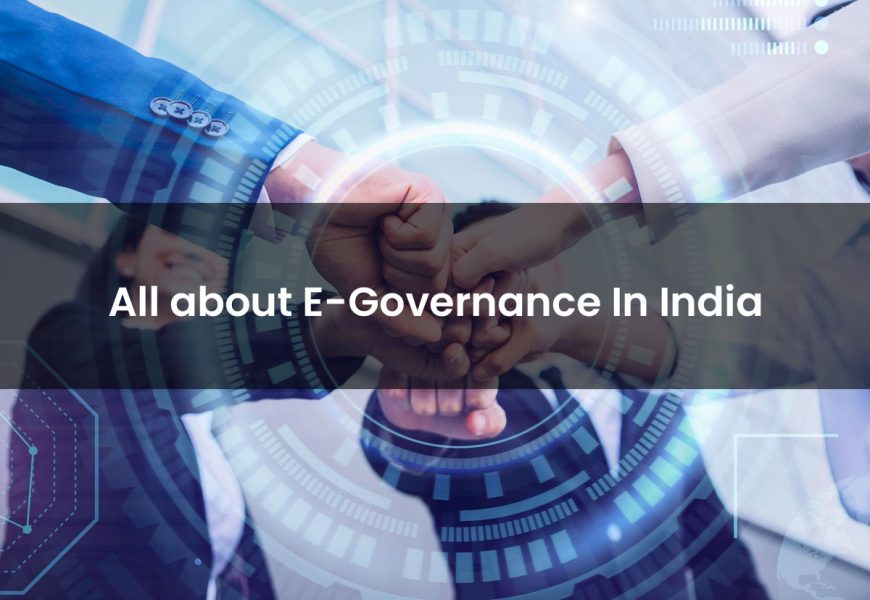
The Digital India initiative was launched in 2015 and is aimed at changing the country into a digitally empowered society. E-Governance projects, digital infrastructure creation, universal internet access, and digitization of government services fall under the Digital India initiative. This project would bridge the gap between the various classes of the society through initiatives like BharatNet, in which broadband connectivity is being given to all gram panchayats. In developing the digital infrastructure, the objective of this program is to provide a strong foundation for transforming India’s governance, increasing transparency, efficiency, and accountability in the government services. With digital platforms such as MyGov.in and DigiLocker, the initiative will find itself uniquely positioned to play a crucial role in determining the future of India in the digital world.
Let’s explore e-governance, the types of interactions involved, and the various initiatives started by the government.
What is e-Governance?

Governments all over the world have established electronic governance or e-governance. In India, this field is rapidly growing with full demand and is a need of the hour. Basic definition: E-governance basically involves the use of information and communication technology by the government for delivering services or, simply, for the exchange of information or integrating different systems.
In more simple words, it is actually the use of technology to deliver on government activities and to fulfill governance goals. Through e-governance, citizens and businesses can access government services conveniently, efficiently, and transparently.
Types of Interactions
The following interactions are involved in e-governance:
Government to Citizens (G2C)
G2C (Government to Citizens) interaction refers to the engagement between the government and its citizens. Its primary objective is to make the government more approachable and user-friendly for the citizens. It enables citizens to tap services of a wide array that are provided effectively. This type of contact expands the reach and access towards governmental service, while its quality is also improved.
Government to Business (G2B)
G2B is yet another e-governance approach in which it gives businesses an opportunity to interact directly with the government, thus saving time and reducing operational costs. It streamlines services to do with licensing, procurement, permits, and revenue collection. This, therefore, will ensure a fair and accountable business environment. Accessing government services online will save them time and reduce visits to offices.
Government to Government (G2G)
G2G (Government to Government) is a mechanism that facilitates smooth communication and collaboration between different government bodies. It has helped to interact easily and efficiently among the different departments and agencies of one government and between two different governments, such as union and state governments or among the state governments. The main intention of G2G is to improve the overall efficiency, performance, and output of government units by streamlining processes, simplifying information sharing, and encouraging better decision-making.
Government to Employees (G2E)
G2E in the administrative perspective, therefore, means government to employees communication. An important ingredient of interaction to a certain extent is government to employees communication as it involves communication between the governing body and its employees to ensure the provision of pertinent information and support needed by the employees from their employers. Developments in the advancement of ICT have been enhanced considerably on the effectiveness and efficiency in handling the communication aspect of G2E. Government organizations can easily and effectively disseminate information and provide services to their employees using ICT tools, such as email, instant messaging, and online portals. Consequently, employees’ satisfaction levels and engagement are boosted.
e-Governance Initiatives in India
The following are the multiple e-governance initiatives in India:
Aadhaar
Aadhaar is a biometric identification program promoted by the Indian government to provide a single and standardized digital identity number for all residents in the country. The basic development of the Aadhaar system was initiated in 2009 with collection of biometric and demographic data, including fingerprints, an iris scan, and other personal information to generate an entirely comprehensive and highly secure record for every individual.
Aadhaar has become perhaps the most ambitious and transformational e-government initiative globally, and far more than just providing a unique identity number. It has simplified welfare entitlement delivery, like food subsidy, pension, and scholarship to the relevant recipient by targeting rightly without duplication. It has also streamlined access to financial services in the form of opening bank accounts effectively and other financial services.
Moreover, aadhaar has simplified digital transactions and reduced the need for physical documents by providing a secure and reliable means of identity verification. The system has also been instrumental in curbing corruption and fraud, providing transparency and accountability in government programs and services.
Digital India
The government had also declared the Digital India programme in 2015 to make the country a digitally empowered society. The scope includes projects pertaining to e-governance, the formation of digital infrastructure, universal internet access, and also digitizing government services. Among the various initiatives undertaken to bridge the digital divide is, for example, broadband connectivity to all gram panchayats as under the BharatNet initiative. It specialises in developing digital infrastructure with a vision to lay out a strong base for digital transformation in India and further increase transparency, efficiency, and accountability in the service of the government. Therefore, it is meant to play a pivotal role in framing India’s digital future through the creation of digital platforms, for example, MyGov.in and DigiLocker.
e-Procurement
The Indian Government has launched several e-procurement portals in order to make the process of public procurement transparent, accountable, and efficient. The online portals have streamlined the procedural and administrative works involved in the process, reduced errors, delays, and inconsistencies, and improved accountability and transparency in public spending. Introduction of e-procurement portals has ushered a paradigm shift in the public procurement system in India and has thus made it more efficient with far greater accountability and integrity in public expenditure.
UMANG
UMANG is part of the Mobile Application launched by the Government of India, with the idea of bringing many government services at the doorsteps of citizens with ease. The application features more than 1,000 services ranging from passport applications and the pension scheme through the departments under the centre and the state government. This is a paradigm example of how much the government is devoted to citizen-centric delivery of services in the simplest and most accessible manner. It exploits the penetration of mobile technology and facilitates an atmosphere of transparency and accountability. The UMANG app allows citizens to experience an easy, seamless interaction with the government and access basic services from the comfort of their homes. It supports many languages and features an array of services from collecting bills to e-governance services to even emergency services, hence basically serving as an all-in-one solution for the needs of citizens.
Swachh Bharat Mission (SBM) – Swachhata App
In 2014, the government launched the Swachh Bharat Mission to achieve universal sanitation coverage and eliminate open defecation across the nation. As part of this initiative, the Swachhata app was introduced. It allows citizens to send complaints related to sanitation, such as litter, garbage being dumped on the street, and filthy public toilets. The app can be characterized as a tool of revolutionary change in the fight against filthy sanitation by giving voice to citizens to articulate their grievances and contribute to making their communities clean. The application increased community involvement in hygiene and sanitation through citizen feedback and information crowdsourcing. The application increased community involvement in hygiene and sanitation through citizen feedback and information crowdsourcing.
The National e-Governance Plan (NeGP)
The National e-Governance Plan (NeGP) is a comprehensive initiative that aims to provide an integrated view of all e-governance projects and programs across India. It entails a vast infrastructure that spans the entire country, including remote villages and facilitates easy access to the Internet and digital records. Through NeGP, the government is undertaking a massive digitisation process to create a reliable and secure platform for accessing critical information. To further strengthen the initiative, the government has proposed the implementation of e-Kranti: National e-Governance Plan (NeGP) 2.0 under the Digital India program.
e-Kranti
e-Kranti is a vital aspect of the Digital India campaign and puts electronic delivery of services at its core. The government has approved the approach and key components of e-Kranti, considering the critical need for e-governance, mobile governance, and good governance throughout the country. The e-Kranti framework consists of a portfolio of mission mode projects that cut across several government departments and aim to ensure the electronic delivery of services to citizens in a streamlined and efficient manner. The projects under e-Kranti are designed to transform how public services are delivered by leveraging technology and innovation. E-Kranti’s ultimate goal of e-Kranti is to improve citizens’ quality of life by making public services more accessible, efficient, and transparent.
Mission Mode Project
A Mission Mode Project (MMP) is a key component of the National e-Governance Plan (NeGP). It is an individual project concentrating on a specific aspect of electronic governance, like banking, land records, commercial taxes, and more. These projects operate under the mission mode principle, implying well-defined goals, scopes, and implementation timelines.
The NeGP includes 31 MMPs, which are categorized under three heads, that is state, central, and integrated projects. These projects have played a very significant role in transforming the delivery of public services into increased transparency and efficiency of government operations. In this regard, they have made it possible for citizens to access all that is on offer from the government’s portal in a more convenient and effective manner, thereby making governance more inclusive and responsive to what the public wants.
National Conference on e-Governance
National Conference on e-Governance is an annual initiative from the Department of Administrative Reforms and Public Grievances in collaboration with the Department of Information Technology along with a state government. The affairs are impressive when it brings in the highest decision making authorities from the states to a conference platform. The conference does bring senior government officials and state government IT secretaries presenting their views and experiences relating to varied e-governance initiatives.
This conference, however, distinguishes and encourages excellence in e-governance by giving awards to government organisations or institutions implementing exemplary e-governance initiatives. It’s indeed a great opportunity for the government officials to discuss and share ideas about improving the quality of services to be issued to citizens through this technology.
Conclusion
E-Governance is a practical way for governments to serve their citizens. Digital technologies can create a better, more transparent, and responsive government that empowers people and strengthens democratic values. We should embrace e-Governance’s opportunities to build a better future for everyone. As we navigate the complexities of the digital age, let us take advantage of this chance to improve things.
Read More – Salary Slip – Meaning, Format, Components & Formulas







